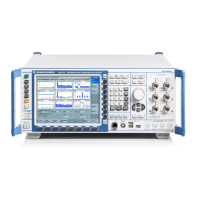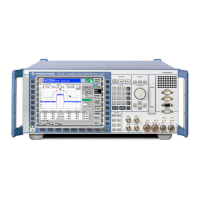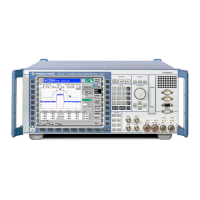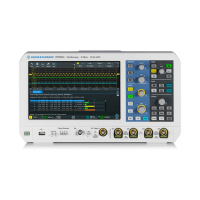Remote Control
R&S
®
CMW500
171User Manual 1173.9463.02 ─ 06
bit 6 being used as well in contrast to the SRE. The IST flag results from the ORing of all
results.
Related common commands
The IST flag is queried using the command *IST?.
The PPE can be set using *PRE / *XPRE and read using command *PRE? / *XPRE?.
See also Common Commands
5.6.3.3 ESR and ESE
The Event Status Register (ESR) indicates general instrument states. It is linked to the
Event Status Enable (ESE) register on a bit-by-bit basis.
●
The ESR corresponds to the CONDition part of an SCPI register indicating the current
instrument state (although reading is destructive).
●
The ESE corresponds to the ENABle part of an SCPI register. If a bit is set in the ESE
and the associated bit in the ESR changes from 0 to 1, the ESB bit in the STatus Byte
is set.
The bits in the ESR are defined as follows:
Bit No. Meaning
0 Operation Complete
This bit is set on receipt of the command *OPC after all previous commands have been
executed.
1 Request Control
This bit is set if the instrument requests the controller function. This is the case when a
hardcopy is sent to a printer or a plotter via the IEC-bus.
2 Query Error
This bit is set if either the controller wants to read data from the instrument without having
sent a query, or if it does not fetch requested data and sends new instructions to the instru-
ment instead. The cause is often a query which is faulty and hence cannot be executed.
3 Device-Dependent Error
This bit is set if a device-dependent error occurs. An error message with a number between
-300 and -399 or a positive error number, which describes the error in greater detail, is
entered into the error queue.
4 Execution Error
This bit is set if a received command is syntactically correct, but cannot be performed for
other reasons. An error message with a number between -200 and -300, which describes
the error in greater detail, is entered into the error queue.
5 Command Error
This bit is set if a command which is undefined or syntactically incorrect is received. An error
message with a number between -100 and -200, which describes the error in greater detail,
is entered into the error queue.
Status Reporting System
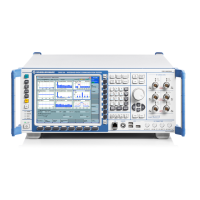
